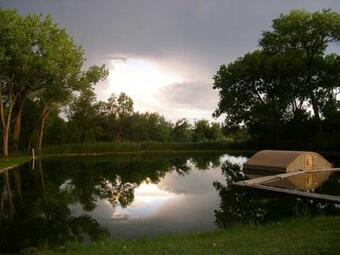Ecology of Carlsbad Caverns National Park
Ecology of Carlsbad Caverns National Park

Carlsbad Caverns is commonly known for its namesake, but the Park includes a variety of ecosystems, including desert and semi-desert grasslands, desert scrub and woodlands, montane chaparral, and montane woodlands. These habitats support diverse plant and animal species, including the Park’s famous bats. Estimates indicate that within the Park’s boundaries, there are 67 species of mammals, 357 species of birds, 55 different reptiles and amphibians, 5 species of fish, and more than 600 insects.
Carlsbad Caverns’ Bats
Bats are often associated with Carlsbad Caverns National Park, and for good reason: 17 bat species call the park home, including the Brazilian free-tailed bat. This species, which weigh only ½ ounce with an approximate 11-inch wingspan, entertains guests with its crowd-pleasing flights every evening in the spring through the fall. Though the number of bats in the resident colony fluctuate, in the summer of 2005, approximately 400,000 were observed in Carlsbad Caverns, and numbers were as high as 793,000 during the 2005 migrations, according to data gathered via advanced thermal infrared imaging cameras and a software program designed to count bats.

The bats leave the cave shortly after sunset. Scientists who study bats, known as chiropterologists, have proposed that as light enters the Bat Cave from Carlsbad Caverns’ second natural entrance, these bats begin to emerge from the cavern. However, scientists say that there are likely other unknown reasons why the bats emerge at this time.
The outflight of the bats can last as long as three hours, and the bats spiral out of the entrance of the cavern in a counter-clockwise direction. The reason they fly in a counter-clockwise direction is currently a topic of research, with one theory being that the bats do so due to the Earth’s magnetic pole. The number of bats returning to the cave typically peaks at dawn.
While the cave myotis and fringed myotis bats have been spotted in the caverns regularly, not all bats roost in the caverns. Other species can be found in the park’s trees and in rock crevices.
Despite their close ties to Carlsbad Caverns National Park, bats face a number of threats, including the white-nose syndrome, a fungus that has led to the death of more than 7 million bats in the United States. During hibernation, bats lower their metabolic rate and body temperature to save energy. However, bats with white-nose syndrome wake up to warm temperatures more frequently, resulting in bats using up fat reserves and starving prior to the arrival of spring. It is thought that white-nose syndrome was introduced from Europe and started to spread in New York in 2006. Though bat populations nationwide are threatened by the fungus, currently, the bats at Carlsbad Caverns National Park do not have white-nose syndrome. National Park Service employees work diligently to keep the bats safe by asking visitors to not wear clothing, shoes or gear to Carlsbad Caverns that they have worn in other caves.
Plants and Vegetation within Carlsbad Caverns
Carlsbad Caverns National Park lies where the northern Chihuahuan Desert, southern Rocky Mountain, and southwestern Great Plains converge, which contributes to the Park’s diverse vegetation. There are approximately 900 species and subspecies of vascular plants within Carlsbad Caverns National Park, including 26 species or subspecies of cacti, 153 species of sunflowers, and 135 species of grasses. Additionally, there are more than 60 types of legumes, more than 30 types of mustards, and more than 30 types of poinsettia.

In 2003, scientists completed a park vegetation map, which documented 85 distinct plant associations within the park. “Plant associations” are groupings of plants species that recur across a landscape. By creating this map of park vegetation, scientists were able to determine that more than half the park is shrubland, one third is grassland, and the rest is a combination of arroyo riparian woodland and shrubland, woodland, and “other,” which includes herbaceous wetlands. documented 85 distinct plant associations within the park. “Plant associations” are groupings of plants species that recur across a landscape. By creating this map of park vegetation, scientists were able to determine that more than half the park is shrubland, one third is grassland, and the rest is a combination of arroyo riparian woodland and shrubland, woodland, and “other,” which includes herbaceous wetlands.

One factor that influences the vegetation found within Carlsbad Caverns is the soil composition. A complex set of soil properties, such as soil texture, mineralogy, or depth leads to differences in vegetation throughout the Park. The presence of vegetation within the Park helps stabilize the soil, so that it can collect and retain water. Soil moisture retention is influenced by topography, texture, structure, and degree of bedrock fracturing. Carlsbad Caverns does not get much precipitation, averaging ~15 inches per year. Throughout the park, different regions receive different amounts of precipitation. The area near Whites City only receives 13 inches, while Guadalupe Ridge receives 20 inches. Approximately 88 percent of the precipitation falls in April through October.

